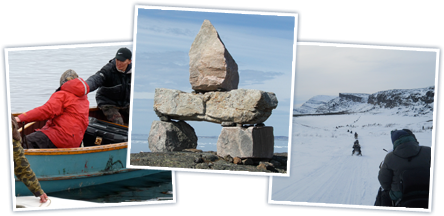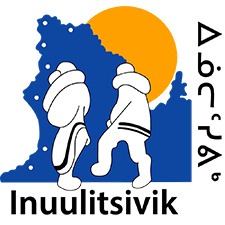
Northern life and Inuit culture
Kuujjuarapik
The name KUUJJUARAAPIK means “small river”(1). It is here that the ministers who came to spread the word of God first arrived. One minister in particular, the Reverend W. G. Walton(2), saw many Inuit each year; he baptized their children and gave them names. I myself was born on January 1, 1914, and he baptized me in 1917; I still have my baptismal certificate even though I am now seventy-seven years old.
The minister baptized the babies and gave them Qallunaat(3) names, but the Inuit continued to call their children by their Inuit names. The minister also married couples who had just met and baptized Elders and adults, both men and women, as well as children. The Inuit did not start hearing about God and Jesus until 1910 or 1920(4). After that, the Inuit came from throughout the Hudson Bay area to learn more about religion. In the winter, the whole family travelled by qamutik.
Only the oldest people stayed behind in the northernmost regions, awaiting the return of their families in the spring. When the families came back, they brought wood to make qajaqs, for in the far north there are no trees.
In those days there were Qallunaat and a priest living in Kuujjuaraapik, so it was a very important village. There was also a trading post – the first along the Hudson Bay coast. There were also Indians.
Today, Kuujjuaraapik is no longer the most important community in the Hudson Bay area, and much of its Inuit population has moved to Umiujaq. Kuujjuaraapik comprises the largest Qallunaat population group on the Hudson Bay.
Location
The northern Inuit village of Kuujjuarapik is located east of Hudson Bay, south of the Manitounuk Islands, on the north shore of Great Whale River. The territory of Kuujjuarapik, designated as Category 1 land, is comprised of 15.3 square kilometers. The surface area of the territory and the rights attached to it are defined by the James Bay and Northern Quebec Agreement. Principal access to Kuujjuarapik is by airplane.
Presentation
Kuujjuarapik has the very special distinction of having four names. The community is known by its Inuit name, Kuujjuarapik, by the Cree name of Whapmagoostui, for the Cree community that shares the territory, by the French name of Poste-de-labaleine, and, finally, by the English name of Great Whale River. The Hudson’s Bay Company set up a trading post, close to the actual site of Kuujjuarapik, in the middle of the 18th century, under the name of Fort Richmond. A Protestant mission was established there in the 1880’s, and the federal government set up a meteorological station there in 1895. The RCMP have had a police station in the community since 1940.
During the 1940’s, the American army created a military base in the community that made an important contribution, although indirectly, to the development of the region. It was during the construction of the base that the Inuit and Cree peoples, hired by the army to work on the project, got their first taste of “cohabitation” and the partnership between these two nations has continued ever since.
The word “Kuujjuarapik” means “the little big river” in Inuktitut. The Inuit of the region use to call their community by the name of “Kuujjuaq”, until this name was chosen for the community of Fort Chimo, and, in terms of geographical accurateness, it should be noted that the mouth of Great Whale River is smaller than the Koksoak River in present-day Kuujjuaq.
The incorporation of the community into a northern village, in 1980, brought about the official adoption of the name Kuujjuarapik. During the negotiations leading up to the signing of the James Bay and Northern Quebec Agreement, a part of the Inuit community at Kuujjuarapik decided to opt for re-localization and they were moved to the newly established community of Umiujak in 1986.
Administration
Local administration is assured by the municipal council of Kuujjuarapik as established by the Northern Village Corporation.
The Northern Village of Kuujjuarapik council is part of the Kativik Regional Authority.
Economy
The hunting of caribou, seal and beluga whale, as well as fishing, most importantly for arctic char, but also some salmon and trout, are the principal economic activities in Kuujjuarapik. The local cooperative is active in retail sales, arts and crafts production, the commercial fur trade, the distribution of petroleum products and recreational development.
Services
There are two hotels in the community: the Sinittavik Inn and a hotel administered by the Fédération des coopératives du Nouveau-Québec.
Kuujjuarapik has a community radio station : Radio FM Inuit 103.5 MHz
(1). The name can also be translated as “narrow river with a strong current”.
(2). William Gladstone Walton was born in Birmingham, England, in 1869, and realized his vocation at the age of eighteen. He soon felt called to join the missions in northern Canada, and he arrived in Fort George in 1892. He travelled for six months out of the year, visiting Amerindians during the summer, by canoe, and Inuit during the winter, by dog sled. His wife, Daisy Alice Spencer, worked with him very closely, deputizing for him in Fort George during his absences. Together, they translated and published a number of books in Cree and part of the Bible in Inuttitut. Reverend Walton’s reputation was such that Inuit travelled from as far away as the Hudson Bay and Strait to hear his sermons, and to have him baptized and marry them. He worked for thirty-two years in the Arctic, retiring in 1924.
(3). The Qallunaat are non-aboriginal people. Literally, the term means “those who pamper their eyebrows”.
(4). In fact, another minister called Peck had already begun making conversions around 1870 in Kuujjuarapik and especially Qilalugarsiuvik (Little Whale River), but Inuit from other regions may not necessarily have come under his influence.
